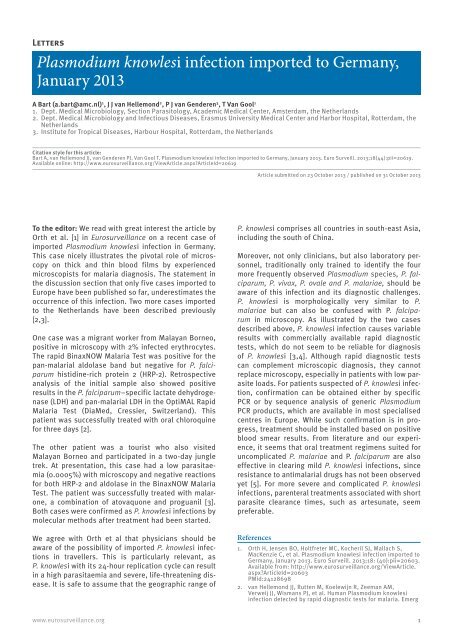Plasmodium knowlesi infection imported to ... - Eurosurveillance
Plasmodium knowlesi infection imported to ... - Eurosurveillance
Plasmodium knowlesi infection imported to ... - Eurosurveillance
Create successful ePaper yourself
Turn your PDF publications into a flip-book with our unique Google optimized e-Paper software.
Letters<br />
<strong>Plasmodium</strong> <strong>knowlesi</strong> <strong>infection</strong> <strong>imported</strong> <strong>to</strong> Germany,<br />
January 2013<br />
A Bart (a.bart@amc.nl) 1 , J J van Hellemond 2 , P J van Genderen 3 , T Van Gool 1<br />
1. Dept. Medical Microbiology, Section Parasi<strong>to</strong>logy, Academic Medical Center, Amsterdam, the Netherlands<br />
2. Dept. Medical Microbiology and Infectious Diseases, Erasmus University Medical Center and Harbor Hospital, Rotterdam, the<br />
Netherlands<br />
3. Institute for Tropical Diseases, Harbour Hospital, Rotterdam, the Netherlands<br />
Citation style for this article:<br />
Bart A, van Hellemond JJ, van Genderen PJ, Van Gool T. <strong>Plasmodium</strong> <strong>knowlesi</strong> <strong>infection</strong> <strong>imported</strong> <strong>to</strong> Germany, January 2013. Euro Surveill. 2013;18(44):pii=20619.<br />
Available online: http://www.eurosurveillance.org/ViewArticle.aspx?ArticleId=20619<br />
Article submitted on 23 Oc<strong>to</strong>ber 2013 / published on 31 Oc<strong>to</strong>ber 2013<br />
To the edi<strong>to</strong>r: We read with great interest the article by<br />
Orth et al. [1] in <strong>Eurosurveillance</strong> on a recent case of<br />
<strong>imported</strong> <strong>Plasmodium</strong> <strong>knowlesi</strong> <strong>infection</strong> in Germany.<br />
This case nicely illustrates the pivotal role of microscopy<br />
on thick and thin blood films by experienced<br />
microscopists for malaria diagnosis. The statement in<br />
the discussion section that only five cases <strong>imported</strong> <strong>to</strong><br />
Europe have been published so far, underestimates the<br />
occurrence of this <strong>infection</strong>. Two more cases <strong>imported</strong><br />
<strong>to</strong> the Netherlands have been described previously<br />
[2,3].<br />
One case was a migrant worker from Malayan Borneo,<br />
positive in microscopy with 2% infected erythrocytes.<br />
The rapid BinaxNOW Malaria Test was positive for the<br />
pan-malarial aldolase band but negative for P. falciparum<br />
histidine-rich protein 2 (HRP-2). Retrospective<br />
analysis of the initial sample also showed positive<br />
results in the P. falciparum–specific lactate dehydrogenase<br />
(LDH) and pan-malarial LDH in the OptiMAL Rapid<br />
Malaria Test (DiaMed, Cressier, Switzerland). This<br />
patient was successfully treated with oral chloroquine<br />
for three days [2].<br />
The other patient was a <strong>to</strong>urist who also visited<br />
Malayan Borneo and participated in a two-day jungle<br />
trek. At presentation, this case had a low parasitaemia<br />
(0.0005%) with microscopy and negative reactions<br />
for both HRP-2 and aldolase in the BinaxNOW Malaria<br />
Test. The patient was successfully treated with malarone,<br />
a combination of a<strong>to</strong>vaquone and proguanil [3].<br />
Both cases were confirmed as P. <strong>knowlesi</strong> <strong>infection</strong>s by<br />
molecular methods after treatment had been started.<br />
We agree with Orth et al that physicians should be<br />
aware of the possibility of <strong>imported</strong> P. <strong>knowlesi</strong> <strong>infection</strong>s<br />
in travellers. This is particularly relevant, as<br />
P. <strong>knowlesi</strong> with its 24-hour replication cycle can result<br />
in a high parasitaemia and severe, life-threatening disease.<br />
It is safe <strong>to</strong> assume that the geographic range of<br />
P. <strong>knowlesi</strong> comprises all countries in south-east Asia,<br />
including the south of China.<br />
Moreover, not only clinicians, but also labora<strong>to</strong>ry personnel,<br />
traditionally only trained <strong>to</strong> identify the four<br />
more frequently observed <strong>Plasmodium</strong> species, P. falciparum,<br />
P. vivax, P. ovale and P. malariae, should be<br />
aware of this <strong>infection</strong> and its diagnostic challenges.<br />
P. <strong>knowlesi</strong> is morphologically very similar <strong>to</strong> P.<br />
malariae but can also be confused with P. falciparum<br />
in microscopy. As illustrated by the two cases<br />
described above, P. <strong>knowlesi</strong> <strong>infection</strong> causes variable<br />
results with commercially available rapid diagnostic<br />
tests, which do not seem <strong>to</strong> be reliable for diagnosis<br />
of P. <strong>knowlesi</strong> [3,4]. Although rapid diagnostic tests<br />
can complement microscopic diagnosis, they cannot<br />
replace microscopy, especially in patients with low parasite<br />
loads. For patients suspected of P. <strong>knowlesi</strong> <strong>infection</strong>,<br />
confirmation can be obtained either by specific<br />
PCR or by sequence analysis of generic <strong>Plasmodium</strong><br />
PCR products, which are available in most specialised<br />
centres in Europe. While such confirmation is in progress,<br />
treatment should be installed based on positive<br />
blood smear results. From literature and our experience,<br />
it seems that oral treatment regimens suited for<br />
uncomplicated P. malariae and P. falciparum are also<br />
effective in clearing mild P. <strong>knowlesi</strong> <strong>infection</strong>s, since<br />
resistance <strong>to</strong> antimalarial drugs has not been observed<br />
yet [5]. For more severe and complicated P. <strong>knowlesi</strong><br />
<strong>infection</strong>s, parenteral treatments associated with short<br />
parasite clearance times, such as artesunate, seem<br />
preferable.<br />
References<br />
1. Orth H, Jensen BO, Holtfreter MC, Kocheril SJ, Mallach S,<br />
MacKenzie C, et al. <strong>Plasmodium</strong> <strong>knowlesi</strong> <strong>infection</strong> <strong>imported</strong> <strong>to</strong><br />
Germany, January 2013. Euro Surveill. 2013;18: (40):pii=20603.<br />
Available from: http://www.eurosurveillance.org/ViewArticle.<br />
aspx?ArticleId=20603<br />
PMid:24128698<br />
2. van Hellemond JJ, Rutten M, Koelewijn R, Zeeman AM,<br />
Verweij JJ, Wismans PJ, et al. Human <strong>Plasmodium</strong> <strong>knowlesi</strong><br />
<strong>infection</strong> detected by rapid diagnostic tests for malaria. Emerg<br />
www.eurosurveillance.org<br />
1
Infect Dis. 2009;15(9):1478-80. http://dx.doi.org/10.3201/<br />
eid1509.090358<br />
PMid:19788819. PMCid:PMC2819855.<br />
3. Link L, Bart A, Verhaar N, van Gool T, Pronk M, Scharnhorst<br />
V. Molecular detection of <strong>Plasmodium</strong> <strong>knowlesi</strong> in a Dutch<br />
traveler by real-time PCR. J Clin Microbiol. 2012;50(7):2523-4.<br />
http://dx.doi.org/10.1128/JCM.06859-11<br />
PMid:22573596. PMCid:PMC3405625.<br />
4. Barber BE, William T, Grigg MJ, Piera K, Yeo TW, Anstey NM.<br />
Evaluation of the sensitivity of a pLDH-based and an aldolasebased<br />
rapid diagnostic test for diagnosis of uncomplicated<br />
and severe malaria caused by PCR-confirmed <strong>Plasmodium</strong><br />
<strong>knowlesi</strong>, <strong>Plasmodium</strong> falciparum, and <strong>Plasmodium</strong> vivax. J<br />
Clin Microbiol. 2013;51(4):1118-23. http://dx.doi.org/10.1128/<br />
JCM.03285-12<br />
PMid:23345297. PMCid:PMC3666806.<br />
5. Kantele A, Jokiranta TS. Review of cases with the emerging<br />
fifth human malaria parasite, <strong>Plasmodium</strong> <strong>knowlesi</strong>. Clin Infect<br />
Dis. 2011;52(11):1356-62. http://dx.doi.org/10.1093/cid/cir180<br />
PMid:21596677<br />
2 www.eurosurveillance.org
















